Survey of the Views of Owner Occupier Farmers on Current Issues for Tenant Farming
This survey of owner occupier farmers is part of a series of evidence to support the Agricultural Holdings Legislation Review Group.
2 AGRICULTURAL OWNER OCCUPIERS AND THE LAND THEY OWN
Summary
1. The majority of respondents owned 500 hectares or less of agricultural land, with a quarter owning fewer than 80 hectares. The median size of agricultural land holdings was 142 hectares.
2. Respondents were most likely to farm one holding in-hand. One in five did not farm any holdings in-hand.
3. Half of respondents were aged over 60 years, with a quarter aged over 70.
Land owned by agricultural landowners
2.1 In order to determine the size of their businesses, respondents were asked about the amount of land they owned, how many holdings they farmed in hand and how many people their business employed, both full time and part time.
2.2 Respondents were asked to provide details about the total amount of rural land they owned, which was a sum of agricultural land and non-agricultural land (including forestry).
2.3 As shown in Figure 2.1, the majority of respondents owned 500 hectares or less of rural land (54%), with 32% owning fewer than 80 hectares. Just less than a quarter of respondents owned more than 500 hectares of rural land (23%), with 6% owning more than 5,000 hectares. Twenty three per cent of respondents did not give a figure for the land they owned.
Figure 2.1: Total hectarage of rural land owned
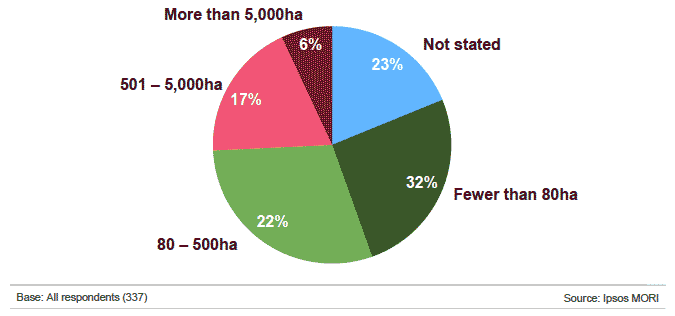
2.4 It should be noted that estimations of the median average size of land owned are not straightforward and there is some uncertainly around these results. This relates to how blank responses are interpreted. A blank response is normally assumed to mean that no land is held in this way as respondents tend not to complete questions that they assume are not relevant to them. However, 23% of respondents did not give a valid response to any of the questions on hectarage[1]. When calculating the median size of land owned, zero and blank responses have been excluded.
2.5 Excluding respondents who did not report any hectarage, the median amount of rural land owned was 166 hectares.
2.6 The figures shown in Figure 2.1 include non-agricultural land owned such as forestry. However, the majority of respondents said that they did not own any non-agricultural land or did not indicate how much they owned (67%). Of the respondents who did provide a figure, the majority (62%) owned fewer than 80 hectares of non-agricultural land. The median size of non-agricultural land owned was 46 hectares.
2.7 In terms of the amount of agricultural land owned (rural land excluding non-agricultural land such as forestry) the majority of respondents indicated that they owned 500 hectares or less of rural land (53%), with 30% owning fewer than 80 hectares. Less than a quarter of respondents said they owned more than 500 hectares of rural land (21%), with 4% owning more than 5,000 hectares. Twenty five per cent of respondents did not give a figure for the amount of agricultural land they owned.
2.8 The median size of agricultural land owned by respondents was 142 hectares[2].
Figure 2.2: Total hectarage of agricultural land owned
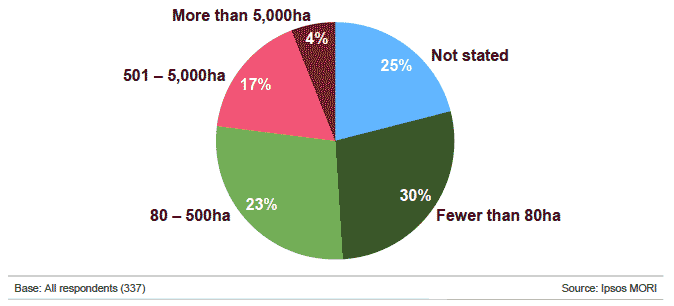
Land farmed in hand
2.9 Respondents were asked how many separate holdings (defined by different County/Parish/Holding (CPH) numbers) they farmed in-hand in Scotland at present (including contract farming) and how many people their business employed on a full time and part time basis.
2.10 The majority of businesses (70%) farmed one holding, 7% farmed two holdings while less than 1% farmed three or more. Twenty one per cent stated that they did not farm any holdings in-hand at present[3], presumably because they had unmanaged farm-land, and 2% did not know (Figure 2.3).
Figure 2.3: Number of holdings farmed in-hand
Q. Including contract farming, how many holdings (with different CPH numbers) do you farm in-hand at the present time in Scotland?
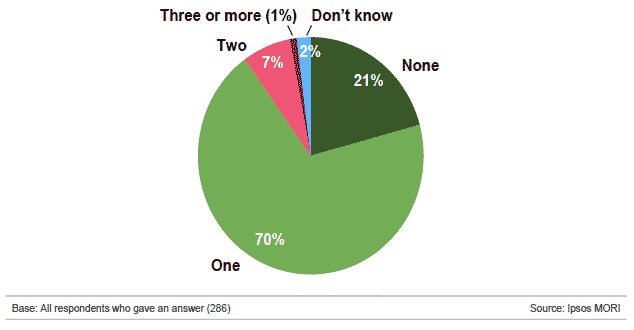
2.11 In terms of employees, 46% of respondents reported that they employed at least one person either full time or part time, while 54% did not have any employees (or did not indicate the number of employees). Respondents were more likely to have part time employees than full time employees, with 35% saying they employed at least one part time employee and 19% saying that they employed at least one full time employee.
2.12 In terms of full time employees, 10% had one full time employee, 7% had two full time employees and 3% had more than three full time employees. Of those who had part time employees, 21% had one part time employee, 12% had 2 part time employees and 2% had more than three part time employees.
Characteristics of landowners
2.13 Respondents were asked about their role in the farming business, when they had taken over ownership/interest in their farm and about their plans for retirement.
2.14 As shown in Figure 2.4, 84% of respondents who provided an answer were actively involved in the management of the business, including farming activities, land based industries and other diversified enterprises. Ten per cent said that they were kept informed of the financial outputs of the business, while 6% oversaw the management of the business.
Figure 2.4: Role in the business
Q. Which of these best describes your role in the business?
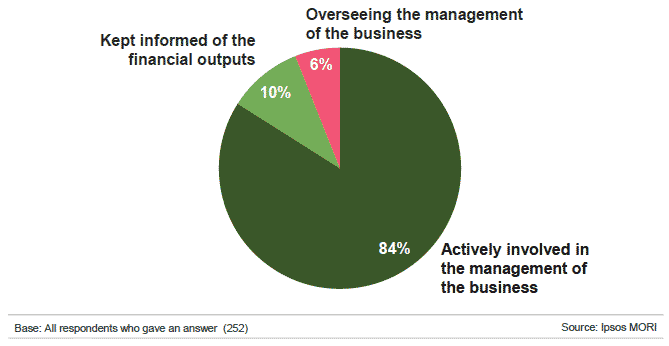
2.15 The majority of respondents, or their family or company, had taken over ownership of/interest in their estate or holding since 1945 (87%), with 38% taking over ownership from 1998 or after. Twelve per cent had taken over ownership before 1946, with 9% taking over between 1883 and 1945 and 3% having done so before 1883 (Figure 2.5).[4]
Figure 2.5: Length of ownership/interest in the estate or holding
Q. Approximately when did you/your family/company take over ownership/interest in the estate or holding, regardless of any business structure changes?
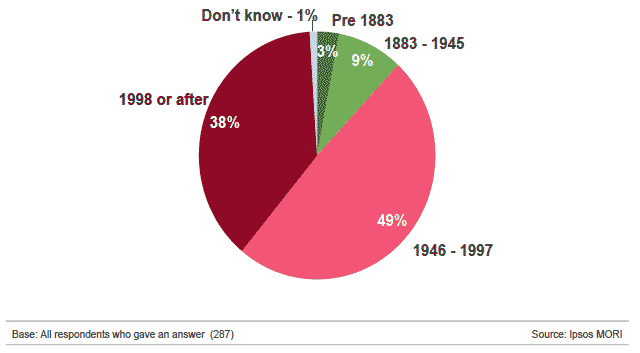
2.16 In cases where land was owned by an individual, family business or a partnership, respondents were asked to provide details of their gender, age, health and their plans for retirement[5].
2.17 Three out of four respondents were male (74%).
2.18 As shown in Figure 2.6, the majority of respondents were aged over 60 (56%), with a quarter aged over 70 (27%). A quarter of respondents were aged 50 to 59 (27%). Around one in five (17%) were aged 49 or younger.[6]
Figure 2.6: Age of respondents
Q. What age group are you in?
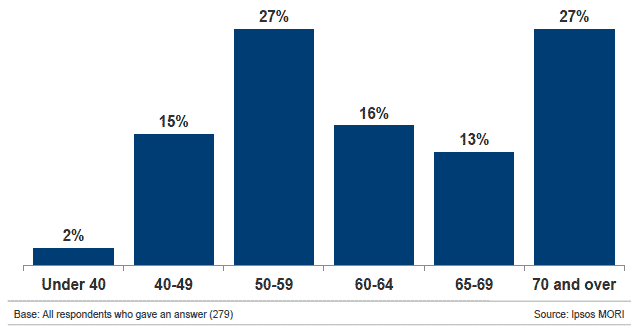
2.19 Male respondents were more likely to be older than female respondents. Fifty seven per cent of male respondents were aged over 60, with 29% aged 70 and over. Twenty eight per cent were aged 50-59 and 15% were aged below 50, with 1% aged below 40. In comparison, 53% of female respondents were aged over 60, with 21% aged 70 and over. A quarter (24%) were aged 50-59 and 22% were aged below 50, with 5% aged below 40.
2.20 One in five respondents (23%) had a long term illness, health problem or disability (including problems due to old age) which limited the daily activities or work they could do. (This compares with a similar proportion (19%) in the general working age population[7]). Of this group, nine out of ten were 50 years or older and more than a half were aged over 65 (92% and 59% respectively).
2.21 Respondents were asked a series of questions on their plans for the succession of their business and their retirement.
2.22 While the majority of respondents (54%) had a successor in mind for their business, with 52% planning to pass on their business to a family member, 18% did not have a successor in mind and were planning to sell their business when they retired (Figure 2.7).
Figure 2.7: Having a successor in mind for the business
Q. Do you have a successor in mind for the business?
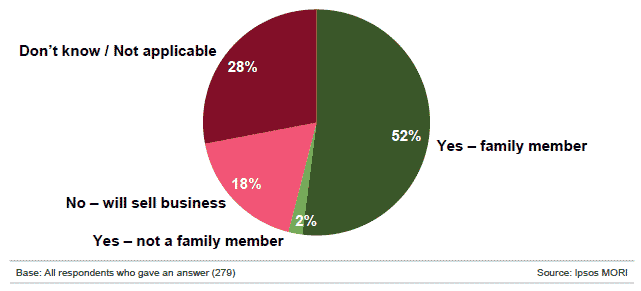
2.23 As shown in Figure 2.8, a quarter of respondents (23%) said that they did not expect to retire until they were over 70 and 18% said that they expected never to retire from their farming business. Nineteen per cent expected to retire aged 66 to 70 and ten per cent expected to retire aged 61 to 65. A quarter of respondents said that they did not know when they would retire (26%)[8].
Figure 2.8: Expected retirement age
Q. At what age do you expect to reture from the farm business?
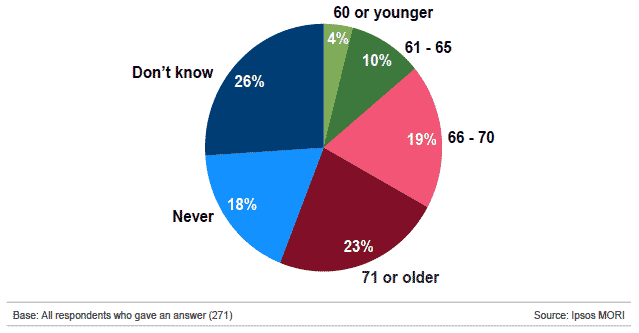
2.24 Factors that respondents thought might prevent them from retiring or from handing their farm over are shown in Figure 2.9.
Figure 2.9: Possible barriers to retirement
Q. Which factors do you think might stop you being able to retire or prevent you from handing over the farm when you want to?
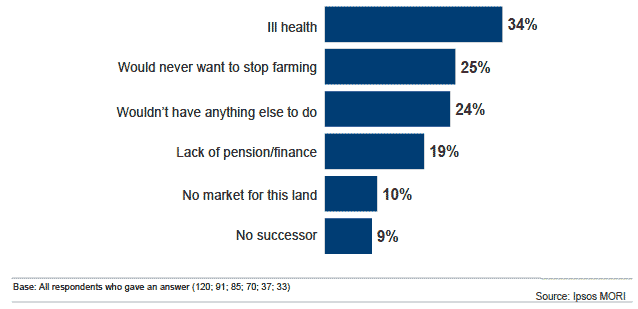
2.25 Ill health was given as a barrier to retiring as early as one would want by a third of respondents (34%). A quarter said that they would never want to stop farming or that if they did stop farming they would have nothing else to do (25% and 24% respectively). One in five respondents said that a lack of pension or finance would prevent them from retiring (19%).
2.26 In terms of pension provision for the future, 44% had general savings, 41% had private pensions and 17% were investing in stocks and shares. Twenty three per cent were not making any pension provision for the future (Figure 2.10).[9]
Figure 2.10: Pension provision
Q. Are you making pension provision for the future?
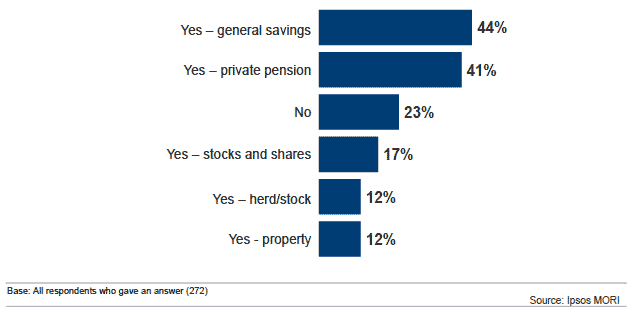
2.27 Those with a successor in place were more likely than those who did not have a successor in place to not be making pension provision (22% compared to 14%).
Contact
Email: Liz Hawkins
There is a problem
Thanks for your feedback